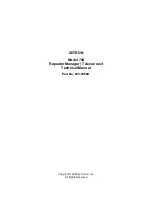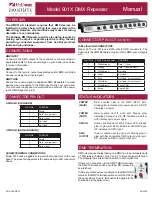
5.1
Terminals are provided for remote mount of a S.P.S.T. “fan
only” switch, rated 240V 60Hz. A jumper across terminals “T2”
and “T3” is installed at the factory, and must be removed and
substituted with the remote switch leads if this feature is to be
available. See Fig. 5.
5.2
A “fan only” switch may be factory installed (optional extra)
directly in the heater.
6.0 FAN DELAY
All RGX unit heaters incorporate a fan delay feature in both the
“ON” and “OFF” cycles. This is a desirable feature allowing the
heater to come to temperature before the fan operates (no cold
blasts) and to cool down in the “OFF” cycle (longer life for the
control components and motor). Delay “ON” is 20-50 seconds
and delay “OFF” is 20-70 seconds.
7.0 REMOTE ENERGY MANAGEMENT CONTROL
Remote energy management control is standard on 40 and 50kW
units. Internal power to contactor coil C2 may be interrupted and
controlled remotely by removing the jumper between terminals
“T2” and “T3”, and then connecting a passive contactor in its
place. A closed contact will allow 100% heating capacity and an
open contact will allow 50% heating capacity. See schematic
wiring diagram Fig. 5.
8.0 NORMAL SEQUENCE OF OPERATION
8.1
The heater must be properly mounted and wired in accordance
with these instructions, terminal cabinet door closed and secure,
fan blade free, and no obstructions to air inlet or outlet areas.
8.2
Energize the heater at the rated supply voltage.
8.3
Assuming the thermostat is calling for heat OR the thermostat
is turned to a higher temperature than ambient:
8.3.1
The main contactor(s) will energize the elements.
8.3.2
The fan motor will not start immediately.
8.3.3
After a delay of 20-50 seconds, the fan contactor will operate
and the fan will start. See paragraph 3.6 for proper fan rotation.
8.4
After the ambient temperature rises to the operating point of
the thermostat, the thermostat contact will open.
8.4.1
The main contactor(s) will de-energize the elements.
8.4.2
The fan motor will continue to operate, purging the residual
heat from the elements.
8.4.3
After a delay of 20-70 seconds, the fan contactor will open
and the fan will stop.
8.5
The cycle described in 8.3 will repeat.
5.1
Un bornier est prévu pour l’installation à distance d’un interrupteur
du ventilateur (U.P.U.D.), 240V 60Hz. Un cavalier est instalé en
usine entre les bornes T2 et T3, lequel sera enlevé et substitué par
les fils de l’interrupteur à distance si cette caractéristique doit être
disponible. Voir Fig. 5.
5.2
Un interrupteur du ventilateur est disponible pour l’installation
intégrée en usine (facultatif moyennant un suppliment).
6.0 COMMANDE À RETARDEMENT DU VENTILATEUR
Tous les appareils RGX sont munis d’une commande à retardement
du ventilateur pour la mise en marche et l’arrêt. Cette caractéristique
unique évite la projection d’air froid au démarrage et la surchauffe à
l’arrêt, d’où une meilleure durabilité des composants de contrôles et
du moteur. Le délai de mise en “marche” est de 20-50 secondes et
le délai “d’arrêt” est de 20-70 secondes.
7.0 RÉGUALTEUR CENTRAL D’ÉNERGIE À DISTANCE
Des borniers intégrés à tous les appareils de 40 et 50kW permettent
d’interrompre la puissance au contacteur C2. En enlevant le cavalier
T2, T3 à bobine du contacteur C2 et en le substituant par un contact
passif, vous réduirez do 50% la capacité de l’appareil selon le signal
de la position ouverte ou fermée commandée par le régulateur
central d’énergie à distance. Voir schéma Fig. 5.
8.0 SÉQUENCE NORMALE D’OPÉRATION
8.1
L’appareil doit être installé et raccordé selon les normes
recommandées pour ce type d’appareil, i.e. Porte du boîtier de
contrôle fermée et verrouillée, aucune obstruction à l’entrée et à la
sortie de l’air, et l’éventail non obstrué.
8.2
Mettez l’appareil sous tension (voir la plaque signalétique pour
tension d’opération).
8.3
En assumant que le thermostat ets en position de demande ou
que le point de consigne est plus élevé que la température ambiante:
8.3.1
Le(s) contacteur(s) principal actionne l’opération des éléments
chauffants.
8.3.2
Le ventilateur ne partira pas immédiatement.
8.3.3
Après un délai de 20-50 secondes, le ventilateur se mettra en
marche. Voir paragraphe 3.6 pour la rotation adéquate du ventilateur.
8.4
Dès que la température ambiante atteindra le point de consigne
du thermostat, les contacts de celui-ci s’ouvrent.
8.4.1
Le contacteur principal coupe l’opération des éléments
chauffants.
8.4.2
Le ventilateur continue de tourner jusqu’à ce que la chaleur
résiduelle de l’appareil est évacuée.
Chauffages pour les environnements les plus rigoureux
MC
MI281 REV.2.01

























